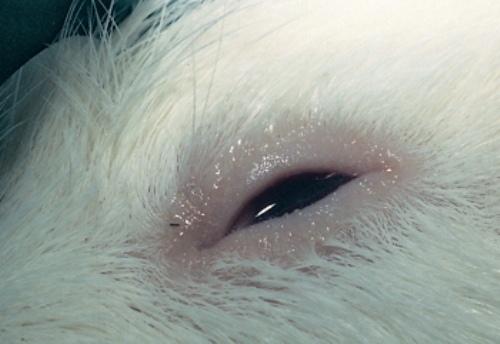Difference between revisions of "Small Mammals Q&A 04"
| (One intermediate revision by the same user not shown) | |||
| Line 3: | Line 3: | ||
|- | |- | ||
| align="center" | [[File:Manson_logo.gif|90px|Mansonlogo]] | | align="center" | [[File:Manson_logo.gif|90px|Mansonlogo]] | ||
| − | | align="left" | This question was provided by [[:Category:Manson|Manson Publishing]] as part of the [[OVAL Project]]. See more [[Category: Small Mammals Q&A|Small Mammals questions]] | + | | align="left" | This question was provided by [[:Category:Manson|Manson Publishing]] as part of the [[OVAL Project]]. See more [[:Category: Small Mammals Q&A|Small Mammals questions]] |
|} | |} | ||
<br><br><br> | <br><br><br> | ||
| Line 14: | Line 14: | ||
If the patient is depressed and uncomfortable, perform the examination as quickly and gently as possible and have oxygen readily available. Do not place an ill guinea pig in dorsal recumbency particularly if respiratory or cardiac disease is suspected. If necessary, use inhalant anesthesia to reduce the stress of examination or diagnostic sampling. | If the patient is depressed and uncomfortable, perform the examination as quickly and gently as possible and have oxygen readily available. Do not place an ill guinea pig in dorsal recumbency particularly if respiratory or cardiac disease is suspected. If necessary, use inhalant anesthesia to reduce the stress of examination or diagnostic sampling. | ||
Use pain relieving medications, such as butorphenol, buprenorphine and flunixin meglumine, as needed. | Use pain relieving medications, such as butorphenol, buprenorphine and flunixin meglumine, as needed. | ||
| − | |l1= | + | |l1=Small Mammal Examination |
|q2= What is the most likely cause of the guinea pig’s condition? | |q2= What is the most likely cause of the guinea pig’s condition? | ||
|a2= The most common cause of anorexia coupled with a wet chin in a guinea pig is overgrown molars. Many factors influence the severity of this condition. | |a2= The most common cause of anorexia coupled with a wet chin in a guinea pig is overgrown molars. Many factors influence the severity of this condition. | ||
| Line 22: | Line 22: | ||
Upper respiratory disease and pneumonia caused by ''Bordetella'' and ''Klebsiella spp.'' or viral agents can also result in oculonasal discharge. ''Chlamydia psittaci'' is a cause of guinea pig inclusion conjunctivitis. | Upper respiratory disease and pneumonia caused by ''Bordetella'' and ''Klebsiella spp.'' or viral agents can also result in oculonasal discharge. ''Chlamydia psittaci'' is a cause of guinea pig inclusion conjunctivitis. | ||
Other causes of oculonasal discharges include chronic hypovitaminosis C and exposure to noxious odors, such as ammonia or volatile oils, from pine or cedar shavings. | Other causes of oculonasal discharges include chronic hypovitaminosis C and exposure to noxious odors, such as ammonia or volatile oils, from pine or cedar shavings. | ||
| − | |l3= | + | |l3=Small Mammal Examination |
</FlashCard> | </FlashCard> | ||
| Line 29: | Line 29: | ||
desc none}} | desc none}} | ||
[[Category: Small Mammals Q&A]] | [[Category: Small Mammals Q&A]] | ||
| − | |||
Latest revision as of 12:45, 16 August 2011
| This question was provided by Manson Publishing as part of the OVAL Project. See more Small Mammals questions |
A two-year-old guinea pig is depressed, thin and anorexic with a clear, watery discharge from both eyes as shown above. The chin is wet from saliva and there is a serous discharge and crusting around the nose.
| Question | Answer | Article | |
| What considerations must you take into account when performing a physical examination on an ill guinea pig? | Guinea pigs have a low tolerance for pain. Inappropriate handling of an ill guinea pig, particularly if it is in pain, can be disastrous. Warn owners prior to an examination that handling severely ill patients can be risky.
If the patient is depressed and uncomfortable, perform the examination as quickly and gently as possible and have oxygen readily available. Do not place an ill guinea pig in dorsal recumbency particularly if respiratory or cardiac disease is suspected. If necessary, use inhalant anesthesia to reduce the stress of examination or diagnostic sampling. Use pain relieving medications, such as butorphenol, buprenorphine and flunixin meglumine, as needed. |
Link to Article | |
| What is the most likely cause of the guinea pig’s condition? | The most common cause of anorexia coupled with a wet chin in a guinea pig is overgrown molars. Many factors influence the severity of this condition.
|
Link to Article | |
| What is the cause of the oculonasal discharge? | The stress of handling can cause clear to milky lacrimal and nasal secretions in the guinea pig.
Upper respiratory disease and pneumonia caused by Bordetella and Klebsiella spp. or viral agents can also result in oculonasal discharge. Chlamydia psittaci is a cause of guinea pig inclusion conjunctivitis. Other causes of oculonasal discharges include chronic hypovitaminosis C and exposure to noxious odors, such as ammonia or volatile oils, from pine or cedar shavings. |
Link to Article | |
